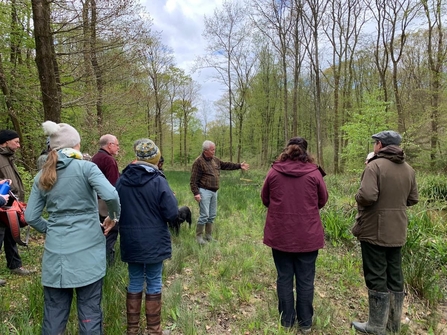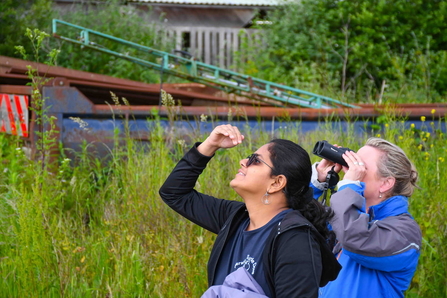Nightingales require scrub habitat and typically nest not far from the ground. Unfortunately, this is also snuffling dog-nose height, which can pose a risk of disturbance and nest abandonment. Turtle doves like to feed on bare earth, with not much surrounding vegetation. They have short legs which can’t cope with too much of a sloping edge to access water; a vital resource for all living things, but especially important for breeding turtle doves, as they use water to produce a crop milk to feed their young. With both species on the IUCN red list and threatened with extinction, these iconic birds are in desperate need of support.
We knew both species had a relative stronghold in Kent. Farmers had reported sightings and were interested in what they could do to encourage these birds. Landowners in the Upper Beult Farmer Cluster had a known nightingale population and were interested in encouraging turtle doves. Those in the Marden Farmer Cluster and Marden Wildlife Group had the opposite; a thriving turtle dove population and wanted to also support nightingales. Collaboration and knowledge sharing are critical factors for successful wildlife conservation, so through discussion with RSPB’s Operation Turtle Dove, two events were planned to bring these groups together.

©️ Kerry Williams
To celebrate these precious species and share findings, the events were held in known hot spots. Firstly, Mike and Jan Bax hosted us at Moat Farm where coppice woodland, scrubbed up pasture, and a network of leaky woody dams make the farm a great place for nightingales. After a talk from Chas of Adonis Blue Environmental Consultancy (ABEC) who have been monitoring nightingale numbers in the area, and Shivani of Operation Turtle Dove, we headed off, stopping at various points along the way to appreciate the space created here for nature. A barn owl box in a field corner, buzzing species rich meadows, good deep hedges. In the woodland we stopped to look at an example of ideal scrub habitat; thick and full for protection from predators (see image below).

©️ Kerry Williams
And just then, we heard it. The unmistakable hail of the male nightingale. After some frantic shushing we all stopped for a moment and listened, absorbing the echoing melody and rattattatt ricocheting off the trees.
We heard a few more nightingales on the route through the farm, which saw us pass through a balance of scrubby understory and open pasture; a mosaic of habitat ideal for these birds. Although an obvious highlight, a blast from the prolific songsters was not the only aim of the day. The walk was peppered with chat of those getting to know each other and sharing knowledge.
The Marden area has some of the most impressive turtle dove records in Kent. The second of our events was held here, at Moatlands Farm. During introductions, the owner, Christine, told us she had seen a regular pair and single male that morning, calling from the telephone wires just beyond the farmyard. Early morning is ideal for turtle doves, so we weren’t expecting these individuals would still be around. However, we had barely left the yard before we saw a small pigeon-like silhouette fly up to settle in a dead tree, classic turtle dove behaviour. Twelve pairs of binoculars soon confirmed it was who we were looking for, before hearing the gentle turr-turring of the turtle dove. I had never heard or seen one, and I won’t forget it.
As we walked on, Shivani showed us ideal areas of bare feeding ground and techniques for scattering mixed seed; a tried and tested recipe which Operation Turtle Dove can provide for farms to encourage the birds. We passed evidently considered wildlife friendly areas; species rich grassland and dense hedgerows, wide field margins and buffer strips.

©️ Tim Horton
We ended our journey at the home of a local community member, Sarah, who was keen to support the group. Here we met Ray from Marden Wildlife to learn more about the group’s contributions to turtle dove monitoring in the area. Conversations were had between organisations with different specialisms on how to engage the local community and other landowners in supporting this critical species recovery work. Members of the varying groups spoke about the work being and yet to be done. An enormous amount of cake was eaten.
Conservation events are often aimed at engaging people in nature, a vital requirement if we are to turn the tide on the climate and biodiversity crisis. However, these events provided more than this. The members of these wildlife and landowner groups are already aware of the plight our natural world faces and have been taking steps to mitigate them for years. They have been working hard to create these spaces for nature and to share them with others, often quietly and whilst facing challenging funding hurdles.
Through collaborating and sharing these experiences with our neighbours, we increase the chances for these near-lost species. Connectivity is crucial for these birds, and all wildlife, so the value of connecting our wildlife rich farmland islands is huge. We hope that through facilitating and supporting more peer-to-peer learning experiences like these events, we can see that happen.

